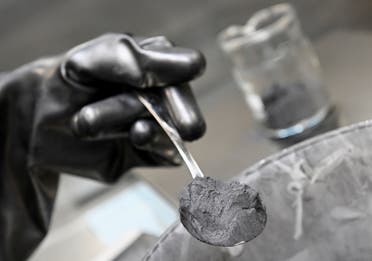An increase in demand for electric vehicles has been supported by governments looking for clean energy solutions as they fight climate change, but there is one major issue being faced: the production of batteries for EVs.
The main ingredient used in the anodes of EV batteries is graphite – usually a combination of natural and synthetic. Currently, China has one of the world’s largest deposits of natural graphite and is a volume producer of synthetic graphite as well.
China’s EV industry is also much more advanced than other countries, including Europe and the United States.
But Middle Eastern countries are also investing heavily in the industry.
China has more than a dozen EV automakers actively mass-producing vehicles.
To date, Tesla is the most active among American EV manufacturers.
“So, the rest of the world is kind of playing catch up,” said John DeMaio, the CEO of Graphex Technologies.

Earlier this year, Lucid announced that it would set up a manufacturing facility in Saudi Arabia to be able to churn out over 150,000 vehicles a year.
DeMaio, responsible for expanding the graphite business into the US and Europe, said his company has consistently produced spherical graphite annually for over a decade and is currently producing over 10,000 metric tons per year, with plans in motion to increase to 40,000 tons over the next 24 months.
Some estimates show the demand for graphite anode material to rise to around 200,000 tons in the US and another 600,000 tons in Europe over the next three to four years. According to DeMaio, the current domestic production capacity in those regions is well below 10 percent of that demand.
“As North America, the EU, and the Middle East advance their efforts to electrify mobility in their regions while simultaneously building out end-to-end domestic manufacturing capabilities, the best companies to effect this transformation quickly are those with proven experience and the willingness to innovate,” DeMaio said. “The build-out of our manufacturing facility in the Detroit Metro area is a major first step in bringing critical mineral supply chains into the heart of the automotive industry. We see this as the first of many such facilities needed to meet the demand on the horizon.”
Graphex Group has historically operated in China, but the US entity, Graphex Technologies, is actively securing sources of natural graphite from other countries, including Canada, Brazil, Australia, and others on the African continent to expand and diversify raw material supply in order to alleviate concentrated reliance on any one region.
Additionally, DeMaio said countries in the Middle East, specifically Saudi Arabia, make “perfect sense” to support the development of natural and synthetic graphite production, given “the tremendous amount of refining expertise that is already in place.”
Al Arabiya




